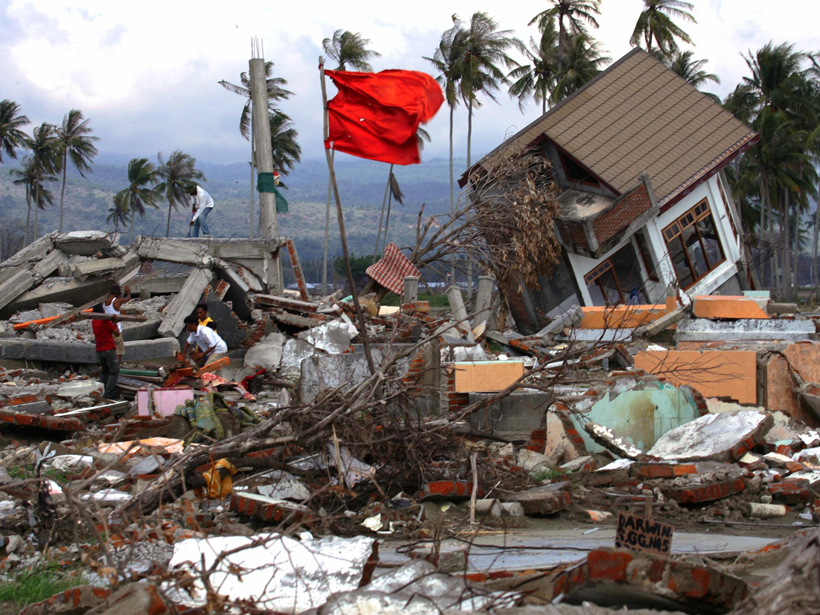The year was 2004. The transformative event was the colossal Indian Ocean earthquake and tsunami. Watching the devastation unfold on television left Alik Ismail-Zadeh, an earthquake modeler, stunned by the depth of the tragedy and the realization that scientists knew enough about prior tsunamis in the region to have prompted protective measures, even though few—if any—such actions occurred.
“What am I doing, as a scientist with my models, if 200,000-plus people within a few minutes lost their lives?”
“What am I doing, as a scientist with my models, if 200,000-plus people within a few minutes lost their lives?” Ismail-Zadeh recalled asking himself as he witnessed the destruction on TV. “Until 2004, I can tell you truly, I was involved in scientific problems related to society. But until 2004, I was more a pure scientist, a theoretician, than a scientist focusing on the needs of society.”
Today Ismail-Zadeh, whose expertise extends to other dynamics of Earth’s crust and interior, such as lava flows, is secretary general of the International Union of Geodesy and Geophysics (IUGG), a major global geosciences organization, and former chair of the Natural Hazards focus group of the American Geophysical Union (AGU), among other AGU roles.
In a recent interview, he told Eos that geoscientists need to think much more about the big-picture concerns facing society, even as they continue to work in their areas of expertise. Among the most pressing concerns in his view are climate change and other environmental problems, dwindling clean water resources, the need for environmentally friendly energy, and sustainability. To tackle those and other challenges, geoscientists need to work with social scientists, engineers, political scientists, and others, he said.
Applying Scientific Knowledge to Benefit Society
IUGG comprises eight semiautonomous associations with specialties in deep Earth interior, seismology, volcanology, the oceans, hydrological and cryospheric sciences, atmospheric sciences and meteorology, geomagnetism and aeronomy, and geodesy. The union also includes several commissions, working groups, and services, many of them multidisciplinary, that “help to bring scientific knowledge closer to society,” Ismail-Zadeh explained. By fostering cooperation among international and intergovernmental organizations, IUGG helps convince governments to apply scientific knowledge for the betterment of societal issues, he added.

Eos interviewed Ismail-Zadeh in late June at IUGG’s General Assembly in Prague, Czech Republic. IUGG is “a vibrant modern scientific union of nations and individual scientists,” Ismail-Zadeh told Eos. In his long-term vision of the organization, it “will promote research and science education linking scientific knowledge to societal needs and working toward a sustainable Earth.”
Moving from Scientific Statements to Action
During his conversation with Eos, Ismail-Zadeh repeatedly emphasized that natural hazards is a discipline in which geoscience can make a big difference. Ismail-Zadeh recently coauthored a paper in Nature about the need for the science of natural hazards to be less fragmented so that it can more effectively raise public awareness and influence policy efforts to increase resilience.
“We should move from scientific statements to real actions.”
“We should move from scientific statements to real actions,” he said. He cited a recent proposal by a transdisciplinary group of experts in disaster risk science established by the International Council for Science and the International Social Science Council. The proposal called for governments attending the March 2015 United Nations World Conference on Disaster Risk Reduction in Sendai, Japan, to establish a science-based assessment process for disaster risk reduction.
Envisioning a World with Fewer Disasters
“To understand disasters is not just to understand natural hazards,” Ismail-Zadeh told Eos. “Disasters are not natural but social. If no people and infrastructure exist, there are no disasters.”
The risk factors for disasters include physical vulnerabilities, such as construction quality of buildings, and social vulnerabilities, such as the behavior of people and their perception of risk, he said. Disasters occur also “because of ignorance, corruption, and irresponsibility. Psychologists, lawyers, the media, and others can contribute to solving the problems,” he added.
Ismail-Zadeh said that he envisions a time when people live in “a better world” of low vulnerability and high resilience to extreme natural events.
“I dream that my great-grandson will show his children an exciting natural event, like a growing rupture of the crust or a moving tsunami wave or a rotating wind,” Ismail-Zadeh said, referring to earthquakes and tornadoes, “and will do it from a balcony of his house, well-protected against natural hazards.
“My descendent will tell his children that ‘scientists in the 21st century, including your great granddad, believed that natural events, which they called hazards, lead in many cases to tragedies in families and result in severe losses of lives and properties. They did not know well how to minimize or, as today, to eliminate disasters.
“‘We know it now. But we should thank them anyway that they thought about us and tried their best to reduce disasters and create a better future for us.’”
—Randy Showstack, Staff Writer
Citation: Showstack, R. (2015), Geoscientists: Focus more on societal concerns, Eos, 96, doi:10.1029/2015EO034063. Published on 10 August 2015.
Text © 2015. The authors. CC BY-NC 3.0
Except where otherwise noted, images are subject to copyright. Any reuse without express permission from the copyright owner is prohibited.

